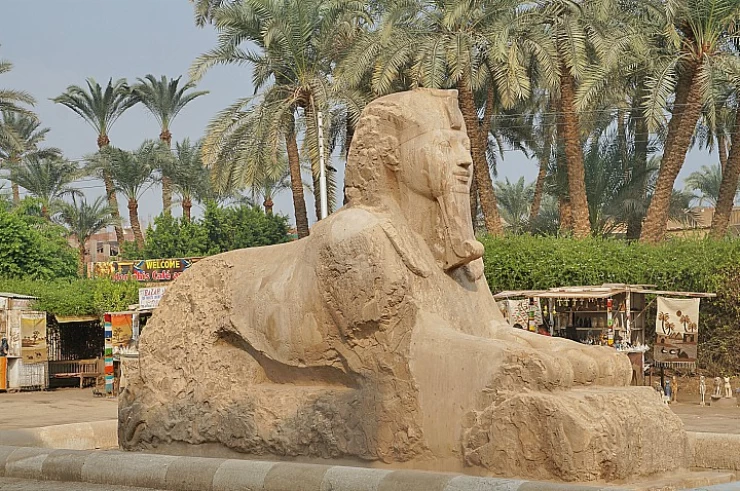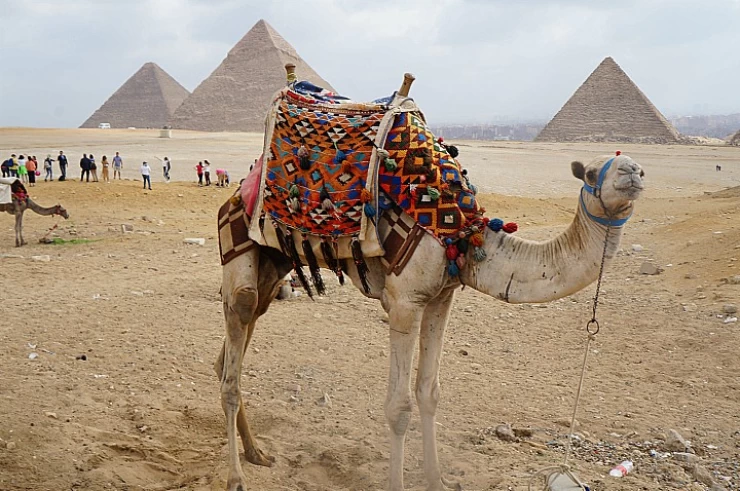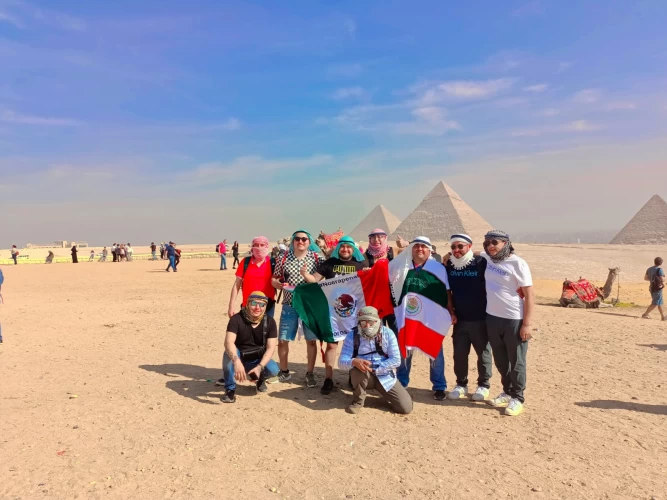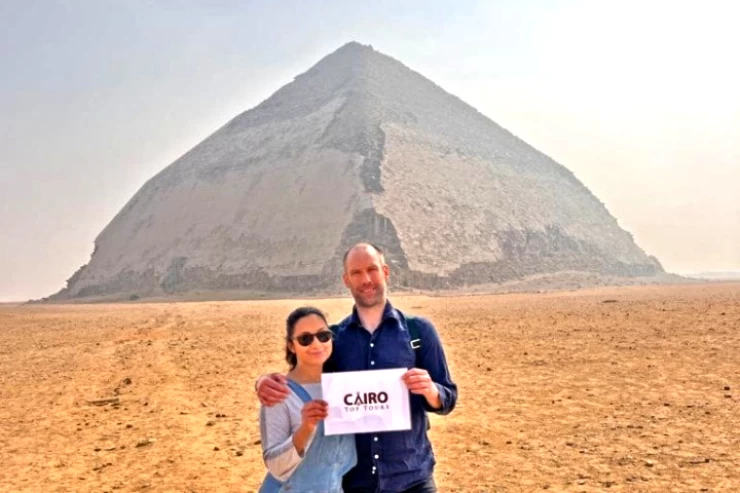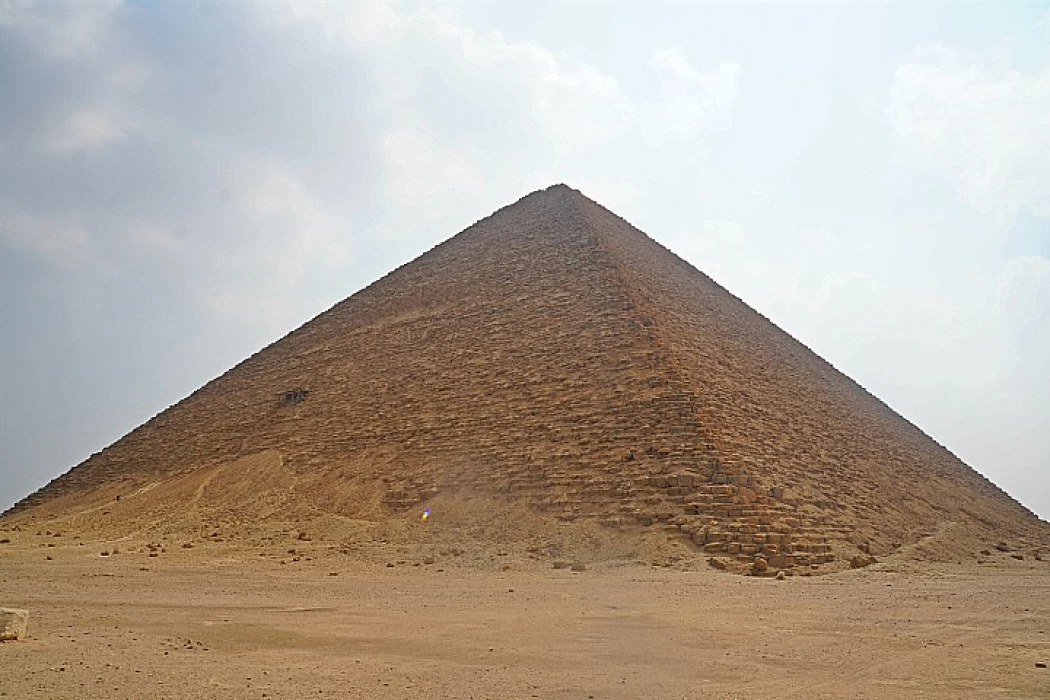
The Red Pyramid Of Snefru
The Red Pyramid, also known as the northern pyramid, is the largest pyramid located in Dahshur in Giza in Egypt. Named for the rusty red color of its red limestone Stones, this pyramid is also the third largest Egyptian pyramid, after the pyramid of Cheops and Khafre in Giza. It is also believed to be the first successful Egyptian attempt to build a "real" smooth-sided pyramid.
The Red Pyramid was not always red. It was encased in white limestone from Tura, but now only a few of these stones remain at the base of the pyramid, at the corner. During the Middle Ages, much of the white limestone of Tora was taken for buildings in Cairo, revealing the red limestone underneath.
The attribution to Sneferu was originally due to the fact that the adjacent necropolis contained only the graves of the officials of this King in addition, the resolution of King Pepi I, located in the valley temple, refers to the pyramid city of Sneferu. This attribution can be confirmed, because in the area of the accompanying temple, a limestone block with remains of hieroglyphs was found in this place, with the name of King Horus: NEB-Maat (one of the royal titles of King Sneferu)
Della Valle gave the first description of the first two chambers of the pyramid when he visited the pyramid in the winter of 1615/1616. Edward Milton visited the Red Pyramid in 1660, as did the bohemian Franciscan missionary Vaclav Remedius protke in the XVIII century. Robert Wood, James Dawkins [5]and Giovanni Battista Borra conducted a preliminary survey in 1750, but could not get to the burial chamber since they did not have a suitable ladder.
At the beginning of the archaeological exploration of the red pyramid were the investigations of John Shea Bering in 1839 and the Prussian Lepsius expedition in 1843. Karl Richard Lipsius catalogued the pyramid in the Lipsius list of pyramids. This was followed by studies by Flinders Petrie and George Reisner. From 1944, more detailed research followed Abdus Salam Hussein and from 1951 Ahmed Fakhri. However, this work was not published. A thorough and systematic investigation was not carried out until 1982 by Rainer Stadelmann.
The pyramid complex was in a restricted military zone until the mid-nineties and is currently the site of numerous excavations. A workers ' settlement of builders and a cemetery were found on the territory.
The Red Pyramid is the third pyramid built by King Sneferu, and is located approximately one kilometer north of the Leaning Pyramid of Sneferu. It is built at the same shallow 43-degree angle as the top of the curved pyramid, which gives it a clearly seated appearance compared to other Egyptian pyramids of similar size. The construction is believed to have begun during the thirtieth year of the reign of Sneferu (C.2590 BC). Egyptologists disagree about the length of time it took to build. Based on Quarry marks found at various stages of construction, Rainer Stadelmann estimates the completion time at about 17 years while Rolf Kraus, based on this graffiti, suggests a period of construction of 10-11 years, an estimate later supported by John Romer (Egyptologist).
Archaeologists speculate that its design may be the result of engineering crises that occurred during the construction of the two previous Sneferu pyramids. The first, the pyramid of Medom in Medom, collapsed in ancient times, while the second, the inclined Pyramid of Sneferu, the angle of inclination of which was significantly changed from 54 to 43 degrees by construction.
Some archaeologists now believe that the pyramid of Medom was the first attempt to build a smooth pyramid, that it may have collapsed when the construction of the curved pyramid had already begun - and that the pyramid may have already begun to show alarming signs of instability by that time, as evidenced by the presence of large wooden beams supporting its internal chambers. The result of this was a change in the slope of the curved pyramid, and the subsequent initiation of the Red Pyramid at a slope that is known to be less prone to instability and therefore less prone to catastrophic collapse.
The height of the Red Pyramid is 105 meters (344 feet).a rare pyramid, or coronation stone, of the Red Pyramid was uncovered and rebuilt, and is now on display in Dahshur. However, it is unclear whether it was actually used at all, since its angle of inclination differs from the angle of the pyramid that it was supposed to use.
The red pyramid, along with the Leaning Pyramid of Sneferu, has been closed to tourists for many years due to the presence of an army camp nearby. It is usually open to tourists and somewhat intrusive ventilation has been installed so that the air is directed under the entrance column to the inner rooms. Visitors climb the stairs cut or built over the stones of the pyramid to a high entrance on the north side. A corridor, 3 feet (0.91 m) high and 4 feet (1.2 m) wide, descends down at 27 degrees for 200 feet (61 M) to a short horizontal corridor leading to a room whose arched ceiling is 40 feet (12 m) high and rises in eleven degrees. At the southern end of the room, but in a westerly direction, another short horizontal corridor leads to the second room. Perhaps this passage was closed at one time and the Offset was a measure aimed at confusing potential thieves.
The second room is similar to the first and is located directly under the top of the pyramid. There is an entrance at the top of the southern wall of the room, which is now accessed by a large wooden staircase built for the convenience of tourists. This gives a short horizontal corridor leading to the third and final room with a 50-foot (15 m) high arched ceiling. The first two rooms have a long axis aligned north-south, but the long axis of this room is aligned east-west. Unlike the first two rooms, which have smooth smooth floors at the same level as the corridors, the floor of the third room is very rough and sunk below the level of the access corridor. It is believed that this is the work of robbers looking for treasure in what is believed to be the burial chamber of the pyramid.
The pyramid rests on a foundation made of several high-quality layers of Tura limestone. The heart of the pyramid, on the other hand, consists of reddish limestone blocks that were extracted from quarries in the immediate vicinity of the pyramid. The current name of the red pyramid comes from the coloring of this material. Inscriptions with dates are found on several blocks of building materials.
The founding block is dated to the "fifteenth cattle counting year", the most recent inscription is in the"twenty-fourth cattle counting year". Based on the information found, one can conclude - provided that the livestock census is carried out every two years - that about a fifth of the pyramid was built in two years. However, the two-year cycle of the livestock census is not undisputed.
The pyramid was built using the improved technologies already used at the top of the inclined Pyramid of Sneferu. The stone layers were now horizontal from the very beginning, so that the pressure inside the pyramid did not increase, which led to cracks and the risk of collapse of the chambers inside the inclined Pyramid of Sneferu. As for the upper side surfaces, the angle of inclination is now set below 44 degrees. John Shay Behring gives it as 43 ° 36 '11", based on the remaining stones of the cladding, with a base dimension equivalent to 219.3 M and a height of 104.4 m. This angle determined by Behring corresponds to an ancient Egyptian angle of 7.35 seconds, that is, the tangent of 7 / 7.35 (= 20/21). Using this angle of inclination, a height comparable to the height of a curved Pyramid of about 105 m (200 cubits) can be achieved by significantly increasing the length of the base to about 220 m (420 cubits). The lateral surfaces of the pyramid core have a slightly concave crease extending upwards from the center of the base. This will improve the stability of the cladding attached to it. Unlike previous buildings, the pyramid was completed without any changes to the scheme.
The pyramid In 1982, R. was discovered.Stadelmann pyramid fragments in the ruins of Dahshur in front of the eastern side of the pyramid, which are considered the oldest of all those that have been found so far and like only two others are from the pyramid of the fourth Egyptian dynasty of the Old Kingdom. The reassembled and restored pyramid is now placed in the area of the funerary temple in front of the Red Pyramid and, like the cladding of the pyramid, consists of good travertine limestone. It is made of a monolithic block and measures an arm (about 1.57 meters) at its base, the angle of inclination of the sides is about 54, which is not exactly the same °. This pyramid is steeper than the remaining remains of the Red Pyramid or the upper part of the neighboring, older pyramid, the pyramid of Sneferu inclined (about 43 degrees) and is as steep as its lower part.there are no inscriptions and no references to the attachment of metal plates, which according to the report of Herodotus are said to have been on the tips of the pyramids.
All corridors and rooms of the red pyramid are located above the base of the pyramid in the brick core. It is the first and only pyramid that does not have underground passages. The reason may lie in the increased identification of the king with the sun god Ra, however, for purely practical reasons, it is conceivable to speed up work on the pyramid by dispensing with underground components. Despite the fact that the chambers are above the ground, they are built on shallow pits at a depth of about 10 meters.
The entrance to the pyramid is located on the northern wall at a height of 28 meters and is shifted 4 meters from the central axis to the East. The Descending Passage leads down 62.63 meters at an angle of 27 degrees to the base of the pyramid. The height of this passage is 0.91 meters, and the width is 1.23 meters. At the foot of the descending corridor there is a short column that was supposed to prevent rainwater from entering the rooms during construction. From there, a short horizontal corridor leads to the first waiting room. Stone fall barriers are not available.
The two waiting rooms have identical dimensions. With a length of 8.36 meters and a width of 3.65 meters, the eleven-level cantilever vault rises to a height of 12.31 meters. In terms of design and visual impact, it is a forerunner of the large exhibition of the Cheops Pyramid. From the south-western corner of the first front room a 3-meter corridor leads to the north-eastern corner of the second waiting room, which is located exactly in the middle of the pyramid. At a height of 7.6 meters on the south side of the room there is an entrance to another 7-meter corridor leading to the actual burial chamber. The wooden staircase in the second waiting room is a modern construction to enable visitors to enter the burial chamber.
The dimensions of the actual burial chamber are 8.55 meters × 4.18 meters with a height of 14.67 meters with a height of 14.67 meters. Unlike the two waiting rooms, they are oriented in the east-west direction, which was an innovation in the construction of the pyramid. No coffin remains were found. The chamber itself was badly damaged by grave robbers who tore off several layers of floor stones. The ceilings and walls are soot-black, which may be due to torches and the possible burning of the wooden coffin by grave robbers. When it was reopened by Bering, the room was partially covered with limestone, which probably came from the restoration of the Ramesside era. When the room was cleaned by Abdus Salam Hussein in 1950, both building stones and loose stones were removed from the floor and lost without documentation. The follow-up examinations carried out by Stadelman could no longer provide any information about the remnants of the original contents of the room.
Unlike other pyramids of the fourth dynasty, the red pyramid does not have a cult pyramid. Perhaps this element was excluded, because the nearby leaning Pyramid of Sneferu took over its function as a symbolic southern Tomb.
The remains of the Temple Road have not yet been found, although it was definitely planned between the Valley and the funerary temple. However, this may not have been completed or even started.
A larger brick building was found southeast of the complex, which apparently housed workshops. The remains of a furnace were also found there.
During the excavations carried out by Stadelman, the remains of a mud-brick building were found in the northeast corner of the pyramid, which was directly adjacent to a wall also made of mud bricks. The exact purpose of the building has not yet been determined, but the connection with the cult of the ruler is obvious.
Further exploratory excavations could prove the perimeter wall around the pyramid. Part of the wall was covered with limestone. The distance between the wall and the pyramid varies from four sides: 15 to 16 meters on the North and south sides, 19 meters on the west side and 26 meters on the east side. Unlike the curved pyramid wall, it is not square, but slightly from East to West.
Stadelmann interprets the fact that the wall was built of adobe bricks instead of limestone like a curved pyramid as evidence that it was built in a hurry to complete the complex. The Northeast building seems to have been a later addition, as the walls were not connected to the surrounding wall.
The funerary temple was largely destroyed and has been preserved only in the form of a few primitive ruins. And it is not yet the size of the funerary temples of the later pyramids. In the center of the temple there was a sacrificial site with a false door in the Inner Temple. A memorial plaque as with the older pyramids of Sneferu cannot be discovered here. There was a stone chapel on both sides of the open courtyard. It is no longer possible to determine whether these chapels were free-standing buildings or were combined with the courtyard and the Inner Temple to form a building complex. The courtyards to the North and south of the temple have circular depressions, which were probably previously used as plant pits or for making offerings. The magazine rooms in the outer area of the temple were made of adobe bricks. It seems that the funerary temple was hastily completed only after the death of snufro, which is evidenced by the change in building materials from limestone to mud brick.
During agricultural work in the spring of 1904, the remains of a limestone fence wall measuring 100 meters× 65 meters were discovered. In the southeast corner of the walls there was a memorial plaque with a decree of the Pharaoh Pepi I Ludwig Borchardt, who secured the stele, holding this find for the wall surrounding the pyramidal city.[15] Stadelman sees it as a perimeters of the valley temple, since the walls of the pyramidal cities (with the exception of Giza) were made of Adobe. The found wall with a thickness of 3.65 square meters is made of yellow limestone and the sloping white facades on both sides correspond in its execution to the sacred architecture. However, there have been no further systematic investigations and the remains in the farmland are now inaccessible.
The Red Pyramid not only solely emphasizes its reddish hue, which is the reason why it was given the Red Pyramid tag. It was also the first correctly built, smooth-sided pyramid instead of its predecessor stepped pyramids, which marked a great achievement in ancient Egyptian architecture, and most importantly, the Pyramid, which all aforementioned pylons were built following.
Sneferu's Architectural Legacy . The construction of the Red Pyramid is dated 2613–2589 BC, when Pharaoh Sneferu ruled over Egypt. This ruler is known in history for having built more pyramids than any other pharaoh of Egypt. The desire to build a perfect pyramid is seen in his other two major pyramid-building endeavors: the Meidum Pyramid and the Bent Pyramid. These two earlier ones, however, encountered some structural problems, with Meidum collapsing at some point in time while the Bent had to undergo a design change at some point as it was not stable.
The Red Pyramid, also known as the Northern Pyramid, resides in the Dahshur necropolis, situated 40 kilometers south of Cairo, where it also presents a more delicate tower-like shape as compared to the rest of the pyramids built before it. The construction of the Red Pyramid was remarkably smooth, thanks to advanced technology and lessons learned from previous projects, thus making it the first pyramid in history designed geometrically to be devoid of irregular surfaces. This will play a big part in his son Khufu constructing the Great Pyramid of Giza, which is one of the Seven Wonders of the Ancient World.
The Red Pyramid, ascending to a height of 104 meters (341 feet) above sea level, is the third tallest pyramid in Egypt after the Great Pyramid of Giza and the Pyramid of Khafre. It was originally a little taller than its present height, but similarly to a lot of ancient Egyptian structures, the outer casing stones were taken away as the years went by, hence the reduction in height.
Easily, one of the most outstanding elements of the architecture of the Red Pyramid is the fact it has smooth sides, which is different from the traditional pyramids that had steps of rising blocks. The slope of the pyramid, however, is a shallow angle of 43 degrees, which made it quite stable; this is because, after the experience with the inclined Bent Pyramid, which had an unsafe 54-degree slope until a third of the way up when they changed it, they understood that too much incline was not safe.
The term “Red Pyramid” is derived from the color of the local limestone used in the construction of the pyramid. Curiously, the pyramid was first covered with polished white Tura limestone that would have made it glitter in the sun. The majority of this outer casing was peeled off over the ages, letting out the reddish core inside. In present times, some of the white casing stones at the base can still be found in the present, showing the visitors how the pyramid was originally constructed.
The enormous size and smooth, sharp corners of the Red Pyramid are proof of the brilliance of Pharaoh Sneferu’s ancient Egyptian architects and their resolve to develop the construction of pyramids to the highest level.
The Red Pyramid, unlike most of the popularly known pyramids of Egypt, allows visitors to go inside, and it is one of the most exciting things to do in Egypt to get into it. The pyramid rests on a passage that snakes its way for quite a distance of 62 meters and leads downwards at an angle of about 27 meters underground.
After completing this passage, the visitors come across the first of the three burial chambers, all with corbel ceilings applied to help avoid crushing the structure by distributing the weight. The temples are magnificent, with cylindrical roofs stretching upwards of 12 meters (40 feet), giving an incredible opening and appreciating the skill of construction that dates back ages.
Without a doubt, the pyramid’s interiors are devoid of carvings or pictorial depictions; however, the grandeur and the feeling of antiquity still stand in great clarity. The red pyramid was however largely believed to be meant for the king’s burials, but it’s mentioned that his body has never been found inside the correct place, hence some history of this pyramid is ambiguous.
The Engineering Genius Behind the Red Pyramid
The Red Pyramid is a landmark construction in the history of ancient Egyptian architecture. After the architect, Sneferu tried to build the Meidum Pyramid but failed, and after the bending of walls in the Bent Pyramid, the skilled builders were able to apply the construction methods that ensured that the Red Pyramid could withstand the test of time for thousands of years.
The composite nature of this pyramid contributes to its success. First, the angle of the pyramid, which is not steep so much, lessens the chances of it falling, making it more stable than the bent pyramid. In the burial chambers, corbelled ceilings were also used to make sure that the ceilings in the inside structure could hold up the great mass of the pyramid, even that of the internal structures. Also, the placement of the stones, some weighing up to a few tons, clearly shows that the ancient civilization of Egypt had a great comprehension of science and could apply it in the structural engineering of the pyramids.
The construction of the Red Pyramid also involved advanced quarrying techniques, with limestone being procured from closer quarries and an extensive workforce used to move and place the stones. While the majority of them are believed to have been recruited laborers, these workers were capable of an extraordinary level of accuracy in the placement and fitting of the blocks to form the pyramid.
The structure sits in pride, displaying the creativity and ambition of Egypt. It is a clear understanding that the pyramids were not only burial places but also an escape of architectural marvels in mankind's journey.
A Hidden Gem for Travelers
In sharp contrast to the lively and heavily visited Giza pyramids, the Red Pyramid welcomes its visitors in a calm and personal way. Being in the Dahshur Necropolis, a zone where there are relatively few visitors, makes it a treasure for those who wish to appreciate the ancient history of Egypt more peacefully.
Both climbing into the pyramid and walking through its narrow, dark corridors and entering inside the vast burial rooms are completely different experiences as compared to the interior of the Great Pyramid of Giza, which is often filled with tourists and under strict security. The Red Pyramid is more conducive for those interested in looking at the ancient civilization, especially since it has not been changed or corrupted.
The Red Pyramid is also in great demand among professional photographers because of its bright red limestone walls set against the brilliant blue sky and the golden desert sands. Visitors can also climb a short way up the side of the pyramid, which presents a view of the Dahshur necropolis that includes the Bent Pyramid and a few other tombs and structures.
The Red Pyramid is located in Dahshour, a conic burial ground for royal figures of the Old Kingdom and other structures. Besides the Red Pyramid, the other pyramid built by Sneferu in Dahshur is the Bent Pyramid, noted for its distinct structure with an angle that altered about halfway through construction. Besides the pyramids themselves, visitors going to Dahshur can also visit other ancient remains, including the smaller pyramids and mastabas, which hint at the activities of the pre-Egyptian dynastic period.
Dahshur being less developed and commercialized is unlikely to appeal to many tourists but is ideal for architectural enthusiasts in the vacationing period. It is a place both for history lovers and daring explorers; one can visit the pyramids and the tombs without the annoying presence of tourists that abound in the other popular tourist locations.







